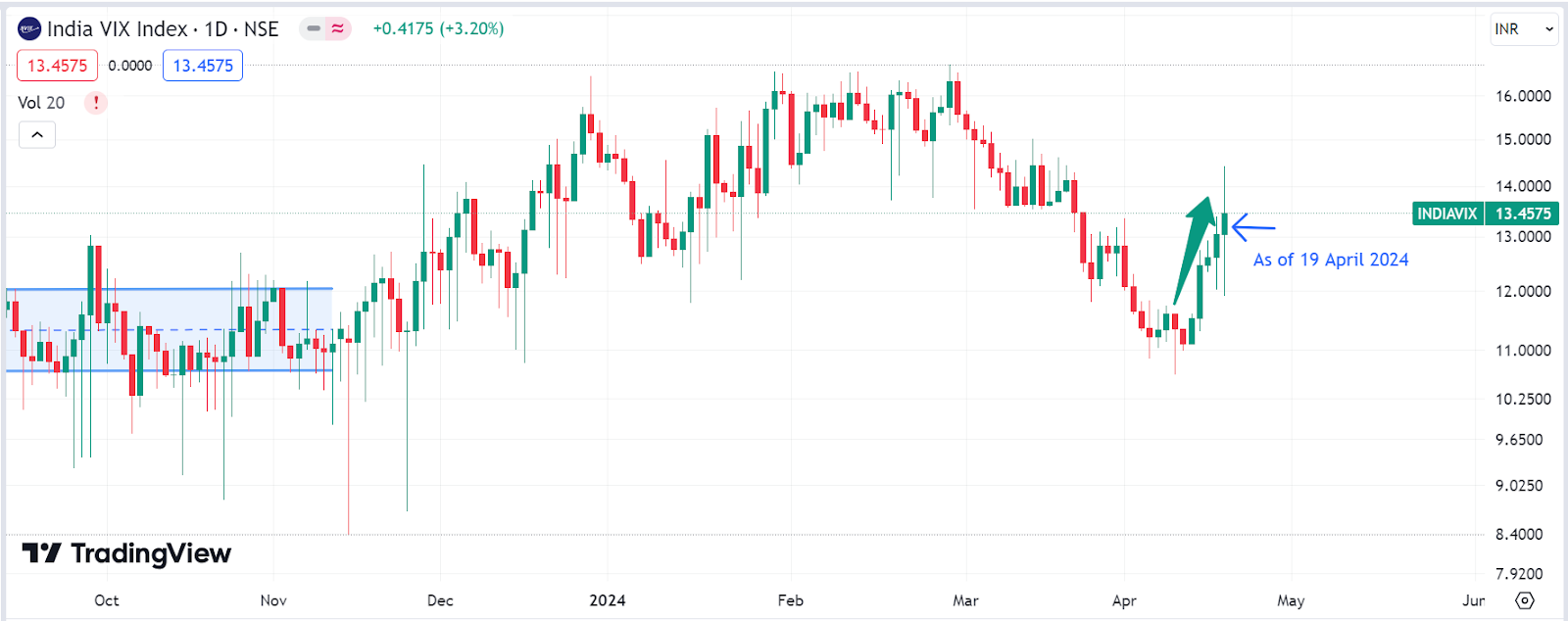


Source: TradingView
India Vix is a volatility Index that reflects the volatility expected in the Nifty 50 Index in the next 30 days. This index is based on the order book of the Nifty 50 option contracts. You can read more about the calculation and the India Vix derivation in the following NSE India link- https://www.nseindia.com/products-services/indices-indiavix-index
The below graph of India Vix represents a volatility of around 11-12% which in turn indicates that the market expects the Nifty prices to fluctuate between +12% to -12% annually over the next 30 days.


Source: TradingView
Normally, Vix could range between 13 to 30. Beyond this range, it could be considered that the market it considered to be highly volatile.
For more understanding and inference of the Vix chart, you can use the refer to the below link- https://zerodha.com/z-connect/general/trading-india-vix-simplified
Note- You can skip this part and move directly to 'India Vix during elections in India' for understanding of India Vix during the period of general elections in India.
Here is a graph comparing the India Vix graph with the graph of Nifty 50 around Feb-March 2020.

Source: TradingView
Inference- The volatility index started moving up around 20th of Feb ’20 and then we notice spikes in volatility (highlighted with the arrows in the left graph above). Correspondingly, on the right graph we notice that the Nifty 50 Index starts experiencing gaps on the way down to the crash.
With each new green candle on the Vix graph, there was a gap introduced in the Nifty graph. Nifty started dropping faster indicating a bearish trend with increased volumes and larger moves in the prices (refer to the larger candles on the right graph).
When the index crashed, Vix moved from +/-15 fluctuation to +/-90 that showed the fear in the market. At the end of the covid crash, Vix had come down to around 20. It remained around 20-25 until the correction of 2021. Then it dropped down on volatility to around 12 at the end of the correction of 2021.
Similarly, we will now see if there is a pattern for Vix during the past elections and if there is an effect on the Nifty performance.
Note- India Vix graph is available only from end of July 2010 and therefore we will cover only the past two general elections and the volatility during those election periods.
Election dates- 7 April 2014 to 12 May 2014
Time Period considered in the graphs – 1 April 2014 to 16 May 2014 (until announcement of results)

India Vix Daily chart. Source- TradingView
We see that volatility index started moving up around the end of March 2014 and kept the pace up until the last day of the elections (12th May 2014). On the last day of elections, it reached peak of around 39 (during that time period). After that we notice a sudden drop in the volatility index on the day of the announcement of results (that is 16 May 2014- highlighted in the graph above). Later it moved down to 13 at the end of July 2014.

Nifty 50 Daily Chart. Source- TradingView
Nifty started moving sideways at the beginning of April 2014, making a slightly downward trend (highlighted within the blue channel in the graph above) by the end of the 2014 elections. We also notice a volume contraction during this period (refer to the circle highlighted in the graph).
Only at the last day of elections, the market saw a move up and by the time of the declaration of results, Nifty was already seeing a bullish trend (please note that this is with reference to the daily chart).
Election dates- 11 April 2019 to 19 May 2019
Time Period considered in the graphs – 1 April 2019 to 23 May 2019 (until announcement of results)

India Vix Daily chart. Source- TradingView
Once again, during the elections of 2019, we see an up move in the volatility index (observe the blue channel highlighted in the graph above). This time, it reached a peak around 30 by 20th May 2019.
Post which, on the day of results declaration, Vix experienced a drop(as seen in 2014 elections as well), eventually reaching the range of 13-15 at the end of July 2019.

Nifty 50 Daily Chart. Source- TradingView
Nifty experienced sideways movement at the beginning of April 2019 (refer to the blue channel highlighted in the chart above) and during the beginning of May ’19, it saw a down move with reasonable volumes, finding support at around 11150 (coming down from around 11800).
Only after the day of the elections (i.e., on 20 May 2019), did it see a move up of around 3.7%, reaching back around 11800.

India Vix Daily chart. Source- TradingView
We are seeing a similar pattern of up move in the volatility index as in the previous two general election periods. There is a rise in the volatility index from 11 (around 10th April) to around 13.5 currently.
We can expect a similar rise in the India Vix in the current and upcoming near term until the end of the election period (which could in turn imply the markets sentiment expecting a fluctuation in the Nifty).
Therefore, we would have to wait for the end of elections to understand the general trend in the market sentiments by studying India Vix’s movement post elections.
Note By: Priyanka Bohra V
Future Corp Capital
19/04/2024
Disclaimer: The data/information compilation in this article is the Author’s comment on general trends in the securities market and discussions of broad-based indices. The information/data provided here is not a research report as defined under the Securities and Exchange Board of India (Research Analysts) Regulations, 2014 (SEBI RA Regulation, 2014). Thus, the Author is not required to have registration as a Research Analyst under the SEBI RA Regulation, 2014.
The information/data provided in this article is from publicly available data, and appropriate references have been given, which we believe are reliable. While reasonable endeavours have been made to present reliable data related to current and historical information, the Author does not guarantee the accuracy or completeness of the data/ information in this article. Accordingly, the Author or any of his connected persons, including his associates or employees, shall not be in any way responsible for any loss or damage that may arise to any person from any inadvertent error in the information/data contained, views and opinions expressed in this article.
The information/data provided in the article is purely for information purposes and to disseminate knowledge on the general trends in the securities market. The same does not constitute investment recommendation/advice or an offer or solicitation of an offer to buy/sell any securities.
No person should rely solely on the information/data in this article and must make investment decisions based on their own investment objectives, judgment, risk profile and financial position. The recipients of the article may take necessary professional advice before acting on it.
Investment in securities market are subject to market risks. Read all the related documents carefully before investing.
Source: TradingView